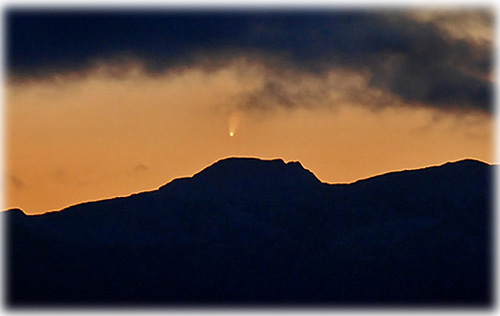 January 13, 2007
This unexpected comet is a
relative newcomer to our solar system and was discovered by Australian
Robert McNaught on August 7, 2006 from his observatory in New
South Wales.  Photograph by Karla Hayward
The material ejected from the comet forms the tails. There are two tails, the dust tail and the gas - or ion - tail. The dust tail is the brighter and is formed by the intense sunlight forcing dust particles away from the comet. The solar wind, a constant stream of material flowing from the Sun, drags ionized gas from the comet to create the ion-tail. Researchers Karl Battams and Jeff Morrill at the Naval Research Laboratory in Washington, DC are planning colour filter observations of these two comet tails. "Close to the Sun the ion and dust tails move apart, a phenomenon that is often difficult to observe from the Earth. By measuring the ion-tail angle we can get information about the solar wind speed very close to the Sun," says Morrill. Comet McNaught is moving through space on an inclined orbit. This will carry it above the Sun's north pole and across the Sun's equator, a place where there is a reversal of the magnetic properties of the solar wind. Crossing this boundary could cause the comet's ion-tail to fragment. Observations of such events are generally very rare, so SOHO's images of comet McNaught constitute an exciting opportunity for scientists. After SOHO's work is finished, the comet will emerge from the Sun's glare and become visible again to earthbound sky watchers in the Southern Hemisphere. "It could become a really bright object in the twilight sky," says Fleck. The ghostly veils of a bright comet are amongst the most spectacular of sights that can be seen in the night sky. Comet McNaught (C/2006 P1) is passing by the sun this weekend. At closest approach it will be 0.17 AU (25 million km) from the sun. For comparison, Mercury is more than twice as far away, 0.38 AU (57 million km). Solar heating continues to puff up the comet, making it the brightest comet in more than 30 years. Between the 12th and 15th of January, Comet McNaught will not be visible from Earth but everyone can still track the comet's passage near the Sun by looking at the SOHO images at http://soho.esac.esa.int/hotshots/. Late next week, the comet will emerge from the sun's glare in good position for evening viewing from the southern hemisphere.
Publish A Letter on SitNews Read Letters/Opinions
|